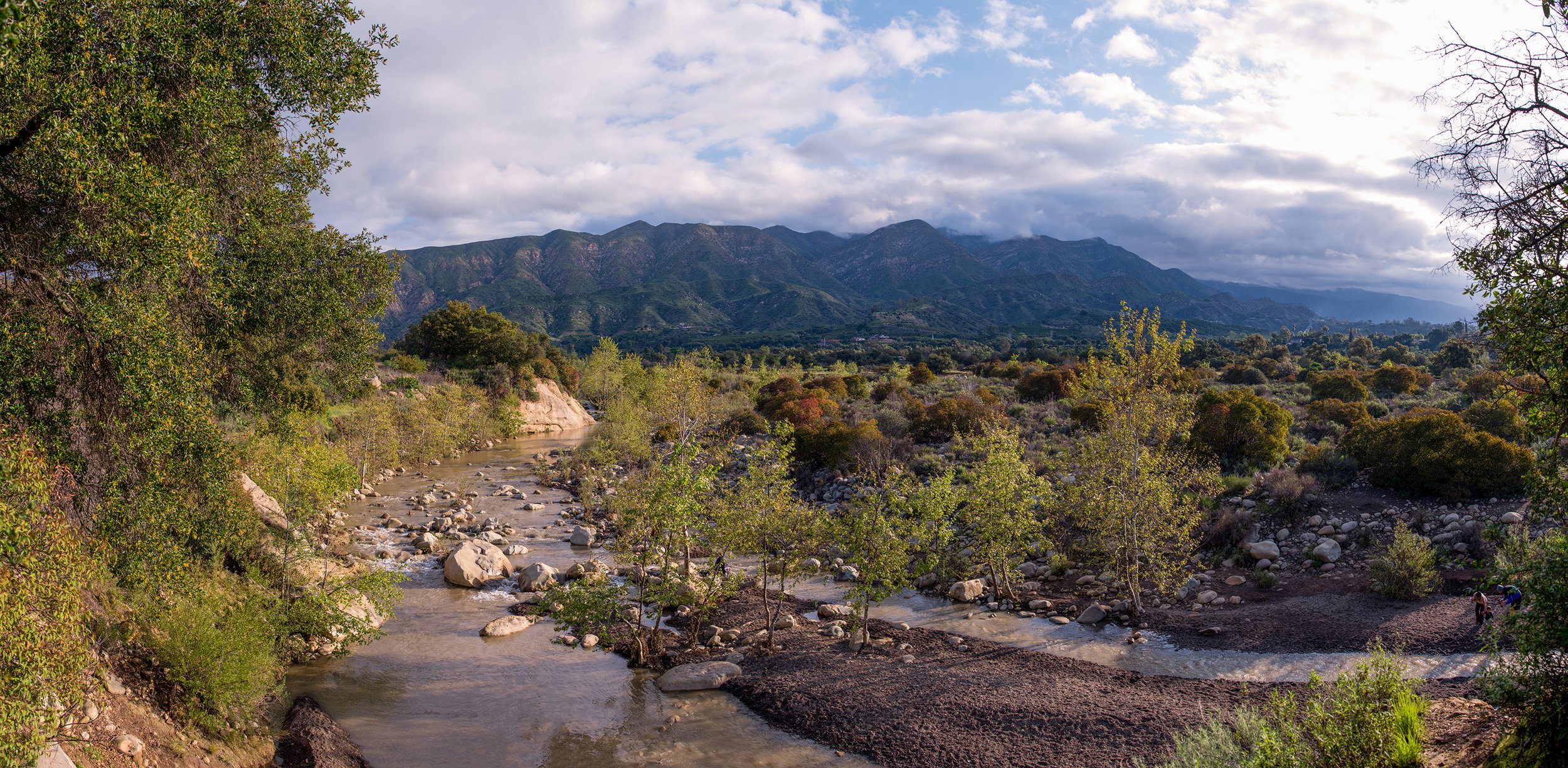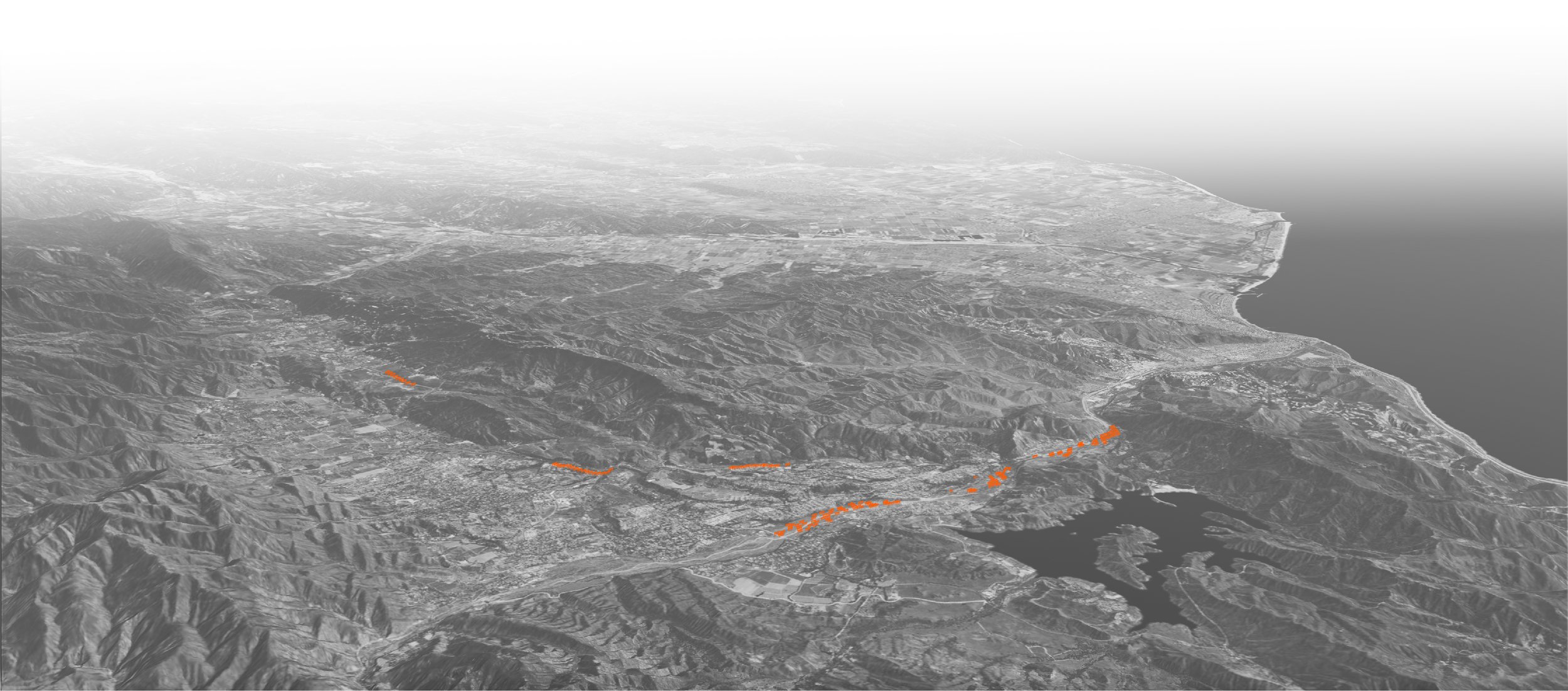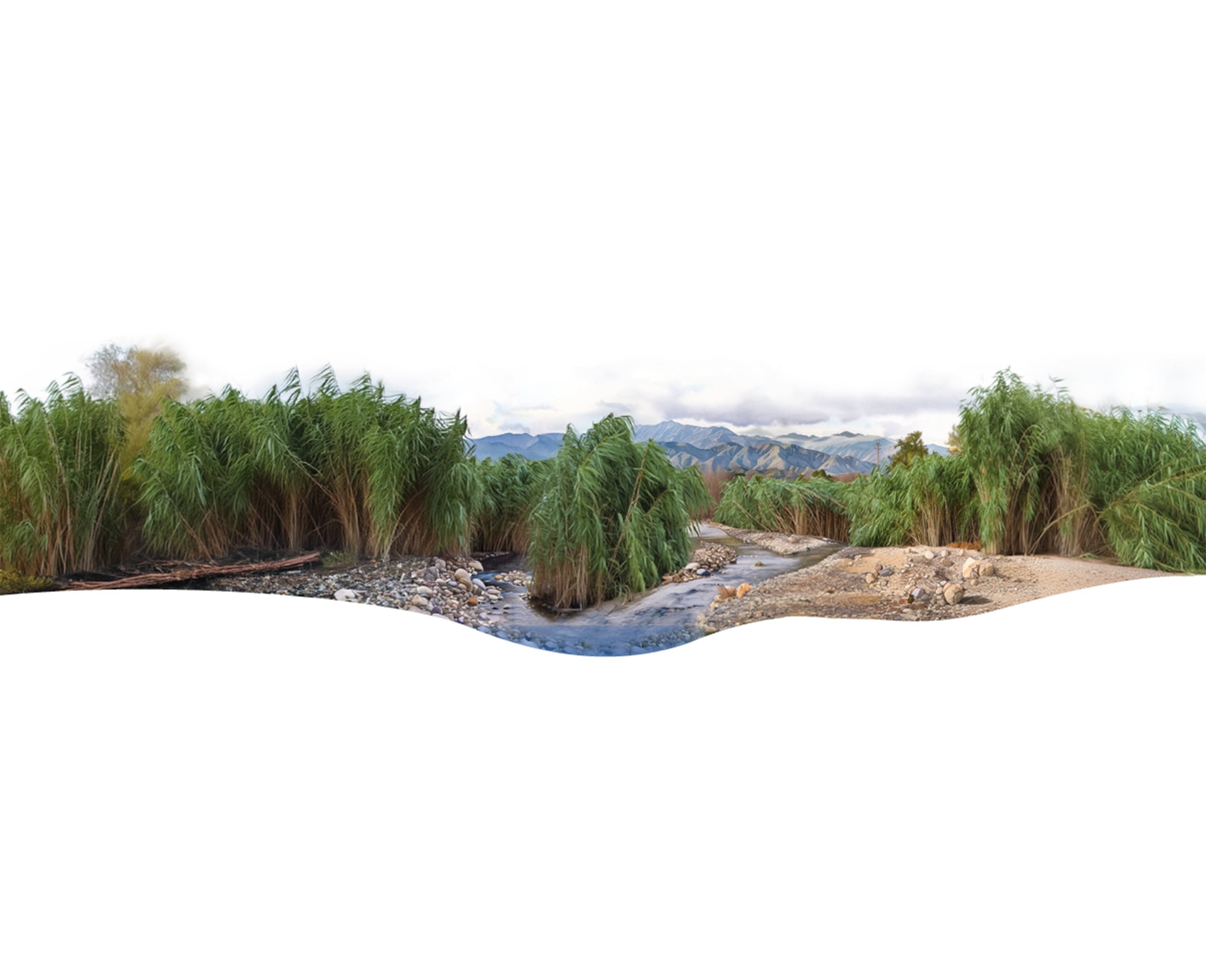
Rewild Our river
Ventura River Watershed Riparian Resilience Program
The Problem: What’s Arundo and why do we care?
This map shows the recorded cases of Arundo throughout the Ventura River Watershed. Arundo is an aggressive, highly invasive grass that resembles bamboo and can grow in dense stands up to 30 feet tall.
Arundo threatens our water supply, exacerbates flood hazards, disconnects important habitats, and creates a dangerous fire risk. It also grows prolifically, and requires precise, skilled techniques to effectively remove it. OVLC has always viewed Arundo as a threat and has worked for decades to remove it from our preserves.
Our recent drone mapping shows that 250 acres of Arundo remain on Lion Creek, San Antonio Creek, and the Ventura River, giving us a clear, tangible goal of achieving an Arundo-free, restored watershed. OVLC has the experience, the permits, and the funds, but we can’t solve this problem alone. We need a holistic plan, landowner participation, and community vision to completely remove this invasive weed and restore the waters we love.
Arundo removal is not new to our watershed. Removal projects have been successful and ongoing since 2007, with 270 acres of removal and restoration already complete.
How does arundo Affect our watershed?
Arundo forms dense stands that displace native vegetation. These monoculture stands provide less habitat and food for native wildlife, and outcompete native plants.
OUTCOMPETES NATIVE VEGETATION
OBSTRUCTS VIEWSHEDS & ACCESS
Arundo is an aggressive invasive grass that can grow in dense stands up to 30 feet tall. Its towering height obstructs views and dense stands cut off access to our creeks and waterways.
DEPLETES WATER SUPPLIES
Arundo consumes large amounts of surface and groundwater—four times as much as native riparian plants! Estimates are as high as 20 acre-feet per acre annually. Removing one acre of arundo can provide enough to supply water to 40 homes a year!
INCREASES EROSION
Arundo’s root masses, known as rhizomes, are bulky and shallow-rooted. These large masses alter the path of water in our creeks. Also, as opposed to our deep-rooted native plants, the shallow roots are pulled from the stream banks during storms causing erosion and destabilizing surrounding land.
Shallow-rooted Arundo dislodges and flows downstream during storms. Dense mats of vegetation can dam up and increase the risk and severity of flooding.
Creates FLOOD HAZARDS
EXACERBATES FIRE RISK
While healthy riparian corridors typically function as natural fire breaks, Arundo’s tall, dense stands are extremely flammable, which dramatically worsen the spread of wildland fires. Stands of Arundo are also known to cause spotting and can throw embers up to a mile away.
The Vision: What does a healthy, restored watershed look like?
Click and drag the arrows to see the difference between an unhealthy river infested with arundo and a healthy river teaming with native vegetation.
ARUNDO INfested
VS
Quality of life in the Ojai Valley is intertwined with the integrity of our river and creeks. Over the years, our community has endured some really extreme environmental disasters. In just the last decade, we’ve endured multi-year drought, historic flooding, and the Thomas Fire—the largest wildfire in California’s history at the time. Our watershed has always been a dynamic system, and our natural environment has adapted to flex and flow with the cycles of environmental change, but invasive species like Arundo create a chronic stress that weakens our watershed’s ability to function.
Healthy rivers are resilient to periodic droughts and floods, function as natural fuel breaks that protect our community from wildfire, and provide solace and shade for humans and wildlife alike during hot Ojai summers. Where climate change can feel a bit existential, river restoration is tangible, and an arundo-free watershed is achievable.
Healthy river
Together, we can remove Arundo, restore our watershed, and reconnect with our river and creeks.
Our Methods: How does OVLC remove Arundo?
BEFORE
DURING
AFTER
We are building upon decades of work in the upper watershed, applying precise and effective techniques, and working in partnership with landowners. We are also working with the Ventura County Resource Conservation District and a wide range of government agencies, non-profit organizations, and community members dedicated to community resilience.
While every project is unique, we have committed to using the most precise, effective, and accepted methods for Arundo treatment. We use the cut-and-daub method with an aquatic-safe formula of glyphosate to treat and remove Arundo. This involves cutting live Arundo with hand tools and a licensed applicator precisely daubing (or painting) the herbicide on the freshly cut stalk within two minutes of the stalk being cut. Cut stalks are then removed from the area and broken down into mulch. Because this work occurs in sensitive areas, everything is overseen by a biological monitor. This is a coordinated effort that balances highly technical, surgical application with labor-intensive, manual removal.
You can read more about past arundo projects and the methods used here.
Once removal is complete, the process of restoration can begin. Planting native species can strengthen bank integrity, create habitat for native critters, and return our rivers and creeks to their natural state.
FAQs
-
Still a relatively new practice, ecological restoration is an intentional process of healing the environment. One starts with an analysis of factors contributing to an impaired state of ecological functions. Then, through thoughtful planning one sets forth actions to reverse damages and ideally foster the recovery of these functions and ultimately, a self-healing ecosystem.
Ecosystems are highly influenced by the disturbances (such as grazing, fire or flooding) that are impacting them, both human induced and natural. Introduction and prevalence of non-native species is human caused disturbance that impairs ecosystem function. Invasives are a top global threat to biodiversity. For instance, Arundo not only drastically diminishes biodiversity but also alters channel morphology and wildland fuels loading. In this way, a human induced change is diminishing the resilience of our local stream environments. The restoration of Arundo-infested areas clearly restores hydrological function and ecological resilience.
-
Arundo removal is a top priority for our watershed. The Ventura River Watershed Management Plan lists Arundo removal as a tier 1 project for the watershed, as Arundo removal provides multiple benefits and addresses several issues, such as deficient streamflow, poor water quality/elevated water temperature, lack of riparian vegetation/shade/instream cover, and excessive sediment (Walter, 2015).
In other words, Arundo threatens our water supply, creates flood hazards, accelerates erosion, crowds out native vegetation, and creates a dangerous fire risk. Arundo spreads rapidly through its roots. Just a small fragment can wash downstream and reestablish, which is why we are taking a watershed-scale approach, conducting phased treatments and starting with the source populations on Lion Creek, San Antonio Creek, and the Ventura River, and working systematically downstream over time.
Healthy rivers and creeks are resilient to droughts and floods, function as natural fuel breaks that protect our community from wildfire, and provide solace and shade for people and wildlife alike, which is why OVLC is working with landowners to Rewild Your Creek. Rewild Your Creek is permitted through the Ventura River Watershed Riparian Resilience Program, led by the Ventura County Resource Conservation District (VCRCD) and OVLC. This Program lays out a cohesive plan and approach to remove Arundo from our watershed and restore important riparian habitats. OVLC has over a decade of experience doing this work, and now, with VCRCD’s guidance on permitting, we are partnering with riparian landowners in a coordinated, watershed-scale approach to community resilience.
-
Arundo removal is a coordinated, multi-year effort that balances labor-intensive, manual biomass removal with highly technical, specific herbicide application. We use a method called “cut-and-daub,” that is widely used for habitat restoration. This involves crews cutting Arundo stands with hand tools (chainsaws, weed-whips, loppers) and a state-licensed applicator precisely daubing (or painting) herbicide on the freshly cut stump within minutes. The applied herbicide is an aquatic-safe formula of glyphosate approved for use in sensitive stream habitats because it goes inert if it comes into contact with water. To increase efficiency, we use dye to mark our progress. Cut stalks are hauled out of the stream and broken down into mulch. A biological monitor oversees everything to ensure work adheres to best practices and complies with all permits, and we monitor and report water quality before, during, and after treatments when water is present nearby. The site is monitored regularly and re-treated 1-2 times a year for several years to effectively control regrowth. While the removal of invasive species generally creates space for natural recruitment of native species, OVLC may actively revegetate and maintain areas to encourage this process (this is often dependent on funding availability).
-
We love nature. We wouldn’t use herbicide if there was an effective alternative. Unfortunately, Arundo is an aggressive zombie plant that grows and spreads so quickly that just cutting it down or mowing over it has little impact – it will grow back to 20 feet tall within a year. Digging it up is also ineffective – Arundo has complex root systems and can re-sprout from just a small root fragment left in the ground – and this would cause extreme disturbance and erosion in sensitive streambank areas. Goats wouldn’t be able to make it very far into a dense thicket and don’t find the silica-rich, bamboo-like plants to be very appetizing. We’ve evaluated a wide range of methods and ultimately found that our widely-used treatment methods are the most effective for controlling this noxious, prolific weed, and are implementing best practices to reduce the potential for adverse impacts.
-
We work with state-licensed herbicide applicators, who are trained in the safe use of these regulated chemicals. The herbicide used is called Aquamaster® or Roundup Custom Pro®, an aquatic-safe formula of glyphosate, which means that the active chemical binds tightly to soil and goes inert if it comes into contact with water, meaning that there would be no impacts to water quality or human health, even in the unlikely event of an accident. We include a marking dye to track exactly where the herbicide is applied. We do not use imazapyr (the herbicide used at Soule Park), as it is reported to have long-lasting impacts on the environment, especially native vegetation.
Moreover, OVLC doesn't spray herbicide. Spraying requires the use of surfactants for aerosolization, which increases the potential risk of dispersion via air or impairment to water quality. Instead, herbicide is applied precisely using the “cut-and-daub” method. “Painting” the herbicide onto the cut stumps increases the rate of absorption into the Arundo rhizomes, thus increasing the effectiveness of treatment and decreasing both the volume used and the potential of dispersion via air or water.
Because we are working in sensitive habitat areas, all work is overseen by a biological monitor to ensure work adheres to best practices and complies with all permits, and we report all herbicide use and water quality data to Ventura County and the State. Additionally, when water is present nearby, we monitor water quality before, during, and after treatments. From 2015 to 2021, OVLC conducted 14 treatments to remove 90 acres of Arundo and other invasive species from our Steelhead and Rio Vista Preserves on the Ventura River – water quality monitoring was conducted upstream and downstream of the site before, during, and after each treatment, and testing results showed that there were no amounts of glyphosate detected in any of the samples collected over the six-year period.
-
No, the floods actually made it worse! High velocity flows scoured away Arundo and undercut already destabilized stream banks, accelerating erosion of property. While it may have appeared like Arundo was washed away in the floods, this prolific, fast-growing species is the first to be revived after disturbance because it is able to re-sprout from even small root fragments left in the soil (frustratingly, even in prior treated areas!). Furthermore, scouring created open areas and suitable conditions for new infestations to establish from Arundo root masses that dislodged from stream banks and flowed downstream.
-
At the watershed scale, Arundo threatens community resilience, but these impacts are even more severe for riparian landowners with infestations on or near their properties. Specific impacts to landowners include:
Commonly known as Giant Reed, Arundo grows in dense stands up to 30 feet tall that outcompetes native plants, obstruct views, and cut off physical access to your creek.
Arundo consumes large amounts of water, depleting flows and drying out streambanks.
Complex root systems, known as rhizomes, are bulky and shallow-rooted, exacerbating hazards during storm events. When these rhizomes remain intact, they alter the path of water in your creek, which could cause unexpected flooding. But they are also likely to dislodge completely, eroding and destabilizing your land.
While healthy riparian corridors typically function as natural fire breaks, Arundo is extremely flammable and carries fire. Tall, dense stands cause spotting and can throw embers up to a mile away.
Arundo has minimal habitat value and doesn’t support beneficial insects, pollinators and birds as native vegetation would.
Arundo eradication is incredibly challenging, but has so many benefits to our environment, which is why OVLC is committed to working with individual landowners to completely eradicate it from the watershed. We have the experience and the drive to tackle this issue at the watershed scale, but now we need riparian landowners to join us. We’ve mapped the extent of the problem, developed a watershed-strategy to address it, and secured initial funding; now we are finalizing permitting to mobilize in fall/winter 2024, and we want you to join us.
OVLC currently has funding from CALFIRE for Phase I: Arundo Treatments of source populations on Lion Creek, San Antonio Creek, and the Ventura River through 2029. OVLC is also actively pursuing grant funding for subsequent phases of Arundo removal and riparian restoration, with the intent of progressing downstream each waterway simultaneously. Riparian landowners should contact OVLC directly to learn more about how and when they can participate.
-
OVLC Website. ovlc.org/rewild
CA Invasive Plant Council. Arundo donax: Distribution and Impacts Report. Cal-IPC
CA Office of Environmental Health Hazard Assessment. Glyphosate Chemicals
AquaMaster® Herbicide Information: Label Information, Safety Data Sheet
Roundup Custom Pro® Herbicide Information: Label Information, US EPA Pesticide Information
-
Plant native species! Our native plant are incredible and support a myriad of native critters, can help support bank stabilization, and return our river and creeks to their natural state.
You can learn more about what to plant at https://vegetation.cnps.org
This website contains plant communities, groups of plants that like to grow together in specific environments. In our river and creeks, the following alliances are the most common. Planting these alliances will do the most good for restoring our water ways:
Mulefat thickets (Baccharis salicifolia Shrubland alliance)
California rose briar patches (Rosa californica Shrubland alliance)
Arroyo willow thickets (Salix lasiolepis Shrubland alliance)
Scale broom scrub (Lepidospartum squamatum Shrubland alliance)
Coast live oak woodland and forest (Quercus agrifolia Forest and Woodland alliance)
Poison oak scrub (Toxicodendron diversilobum Shrubland alliance)
Still have questions? Email rewild@ovlc.org.
Where do you fit in
-
Please email restoration@ovlc.org or call Rhett Walker, Grants Manager, at 805-633-4680 to start the process.
-
The best way to help is to participate in citizen science!
Contribute any arundo observation to iNaturalist and join the following project to help OVLC track down all the arundo in the watershed.
-
Please email restoration@ovlc.org or call Rhett Walker, Grants Manager, at 805-633-4680 to learn more.












